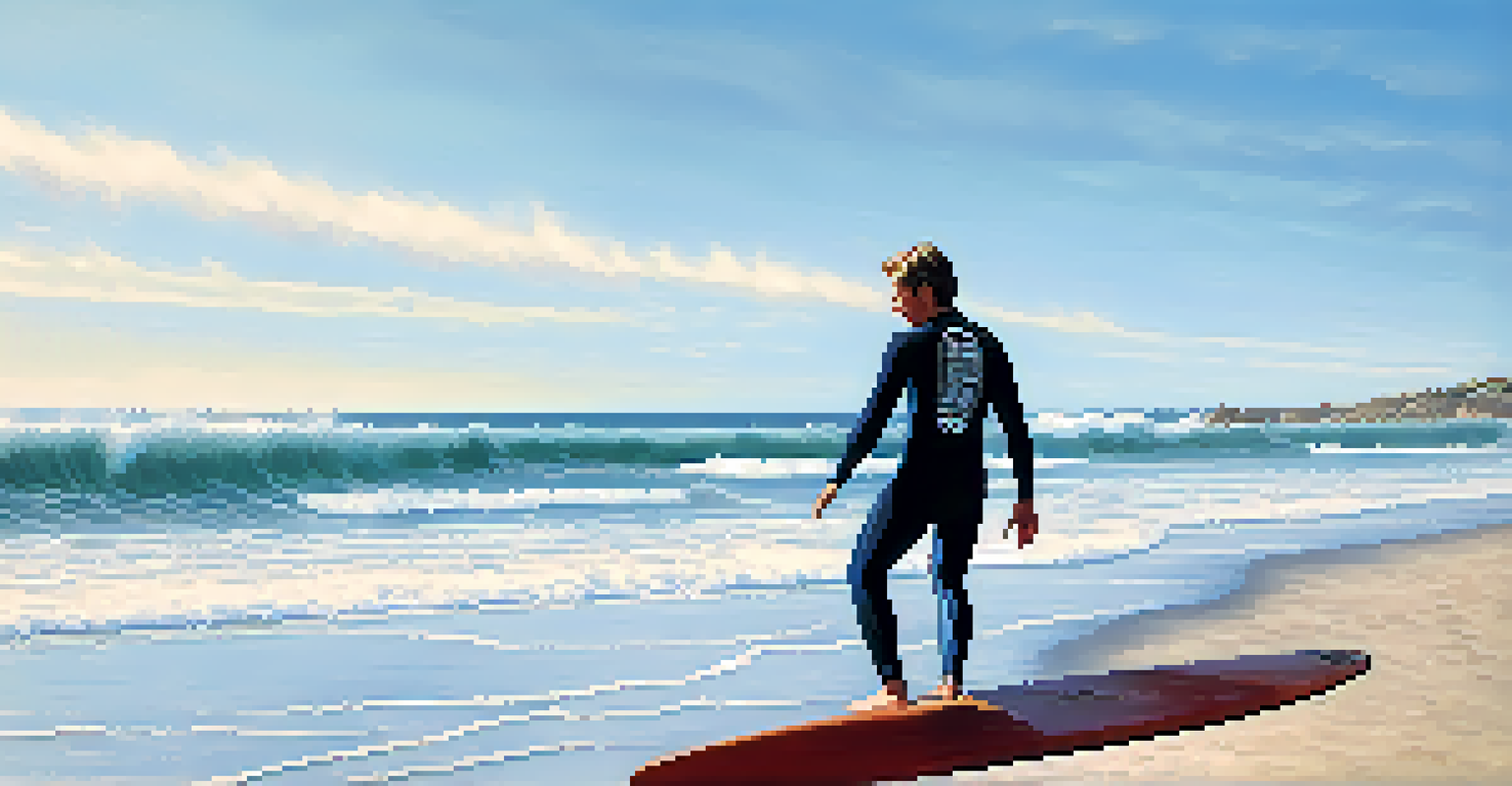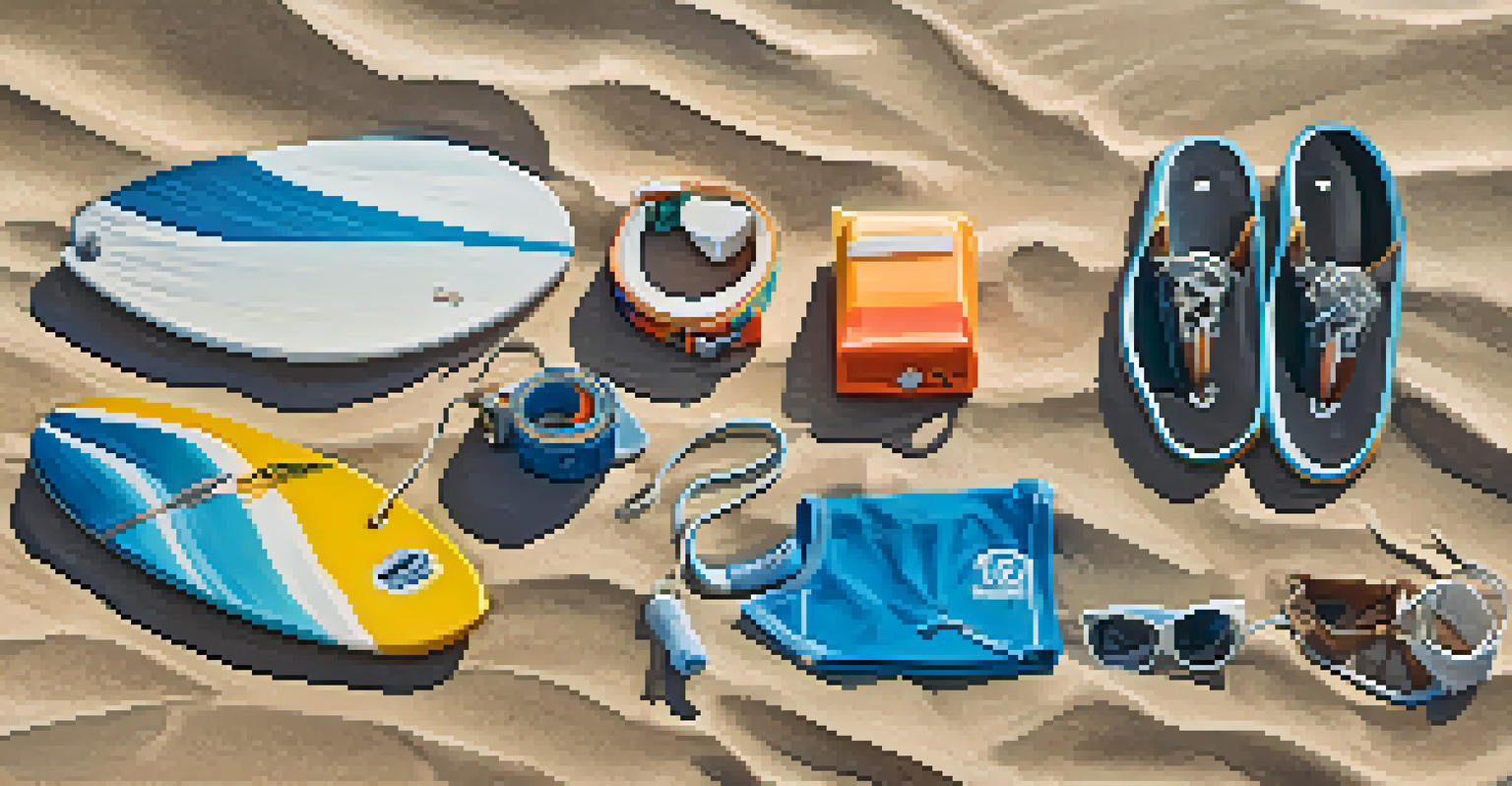Surfing Safety Tips for Beginners in Santa Barbara Waves

Understanding Santa Barbara's Surf Conditions
Before you hit the waves, it's crucial to understand the surf conditions in Santa Barbara. The ocean can be unpredictable, and factors like tides, swell size, and wind can significantly affect your experience. Take a moment to check local surf reports or talk to experienced surfers to gauge the day's conditions.
The ocean stirs the heart, inspires the imagination, and brings eternal joy to the soul.
Santa Barbara offers a variety of surf spots, from gentle beach breaks to more challenging reef breaks. As a beginner, it's best to stick to more beginner-friendly spots like Leadbetter Beach or Butterfly Beach, where the waves are usually milder and more manageable. Knowing where you're going to surf can help set you up for success.
Always keep an eye on the weather forecast too. Changes in weather can affect surf conditions and visibility. Being aware of these factors can help you choose the best time to surf and ensure a safer experience overall.
Choosing the Right Surfboard for Beginners
Selecting the right surfboard is essential for beginner surfers. A longer, wider board provides better stability and makes it easier to catch waves. Soft-top boards are particularly popular for beginners because they are forgiving and less likely to cause injury when falling.

Consider borrowing or renting a board to find what feels comfortable before making a purchase. Many surf shops in Santa Barbara offer rentals and can provide helpful advice on what type of board suits your skill level. This can save you money and help you make a more informed decision.
Know Surf Conditions Before Surfing
Understanding local surf conditions, including tides and swell size, is essential for a safe and enjoyable surfing experience.
As you progress, you might want to explore different types of boards, but starting with a beginner-friendly option allows you to build confidence and skills without feeling overwhelmed. Remember, the right board can make all the difference in your surfing journey!
Wearing Proper Surfing Gear for Safety
Wearing the right gear can greatly enhance your safety while surfing. A wetsuit is not only essential for warmth in cooler waters but also provides some protection against abrasions and impacts. In Santa Barbara, a shorty wetsuit is often sufficient, depending on the season.
Surfing is the most fun you can have without taking your clothes off.
Don’t forget about other safety gear like surf booties and a leash. Surf booties offer grip and protection from sharp rocks or sea urchins, while a leash keeps your board attached to you. Losing your board can be dangerous for both you and others in the water.
Lastly, consider wearing sunscreen designed for water sports. The sun's rays can be harsh, especially when reflecting off the water. Protecting your skin allows you to enjoy your time in the ocean without worrying about sunburn.
Understanding Ocean Etiquette for New Surfers
Ocean etiquette is vital for maintaining a safe and enjoyable environment for all surfers. This includes understanding the right of way; the surfer closest to the peak of the wave has priority. Respecting this rule helps prevent collisions and makes the experience more enjoyable for everyone.
Additionally, keep your distance from other surfers and avoid dropping in on someone else's wave. It’s essential to be aware of your surroundings and communicate with fellow surfers. A friendly wave or nod can go a long way in building camaraderie in the water.
Choose the Right Surfboard
Selecting a longer, wider, and softer surfboard can significantly enhance stability and ease for beginner surfers.
Remember, we all share the ocean, so being courteous and respectful can lead to a more positive surfing culture. Practicing good etiquette not only keeps you safe but also helps create a welcoming environment for beginners and seasoned surfers alike.
Learning to Fall Safely While Surfing
Falling is an inevitable part of learning to surf, but knowing how to fall safely can help prevent injuries. When you feel yourself losing balance, try to fall away from your board, as it can cause injury if you land on it. Aim to fall flat, like a belly flop, to distribute the impact across your body.
It's also wise to avoid putting your hands out to catch yourself, as this can lead to wrist injuries. Instead, protect your head by tucking your chin and rolling away from your board if possible. Practicing these techniques on land can build your confidence before hitting the waves.
Falling is just part of the learning process, so don’t let it discourage you! Embrace the tumbles as part of your journey, and with practice, you'll become more adept at navigating the waves.
Recognizing and Responding to Rip Currents
Rip currents are powerful channels of water that flow away from the shore, and they can pose a serious threat, especially for beginners. Learning to recognize the signs of a rip current, such as choppy water, a gap in breaking waves, or foam and debris moving seaward, is crucial for your safety.
If you find yourself caught in a rip current, remain calm and conserve your energy. Instead of fighting the current, swim parallel to the shore until you are out of its grip, then swim back to shore at an angle. It's essential to know this technique before you hit the water, as panic can lead to poor decision-making.
Prioritize Safety and Hydration
Wearing appropriate gear and staying hydrated can help ensure a safer and more enjoyable time in the water.
Always keep an eye on fellow surfers and be prepared to help if someone appears to be struggling. Understanding rip currents not only helps you stay safe but also ensures that you can look out for others in the water.
Staying Hydrated and Rested While Surfing
Surfing can be an exhilarating workout, and it's easy to forget about hydration when you're having fun. However, staying hydrated is crucial for maintaining your energy levels and focus in the water. Make it a habit to drink water before and after your surf session, and consider bringing a water bottle to the beach.
Similarly, listen to your body and know when to take breaks. Pushing yourself too hard can lead to fatigue, which increases the risk of accidents in the water. Take time to rest and unwind, allowing your muscles to recover between sessions.

Remember, surfing is not just about catching waves; it's about enjoying the ocean and keeping yourself safe. Prioritizing hydration and rest will enhance your overall experience and improve your performance as a surfer.